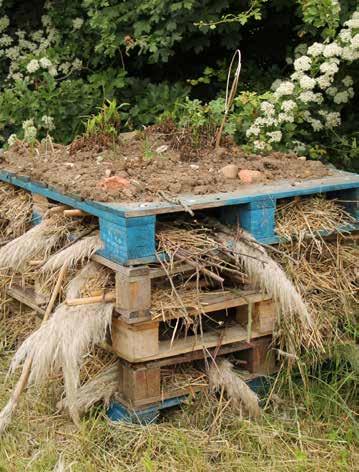
4 minute read
Holiday activities
JUST BOOT-IFUL

Advertisement
Help the kids get creative in the garden and with their wet weather gear

April, as the saying goes, is the month for showers. And not only does it bring May’s flowers, it can also provide inspiration for some great craft activities for kids and adults alike.
It’s the time where it’s always best to have boots and a brolly close at hand.
And there’s no better way of making a splash in those quick-to-appear springtime puddles than in customised wellies.
Boots are very much a blank canvas and you can really let your imagination run riot, creating colourful and simple yet effective flower patterns, rockets and scenes from outer space for the kids – who also might want a jazzy take on their initials - or graffiti-led slogans for the not so young who might be missing their Glastonbury fix again this year.
Many people suggest sanding down the area you intend to decorate as this creates a smoother surface and allows the paint to make a stronger bond. As for your decorating agent, acrylic paint is easily available and straightforward to use, particularly if you are going for a funky, bright and intricate design. Waterproof marker pens are also handy for applying finer details, while if a broad sweep of colour is required, rubber spray paint will do the job.
And although the paints will dry to a good finish, applying a layer of hairspray will also help your colours stick.
Continuing the wet weather theme, how about sprucing up your front door with an extension of the Christmas wreath: a brolly brimming with spring flowers? Younger members of the family can do the backbending stuff by picking the flowers while all you have to do is select an umbrella that’s not your favourite anymore, tie brightly coloured ribbon about halfway up and gently bend the brolly support wires outwards.
Insert a block of florists’ oasis for water and support then add the flowers so they are peeping over the top. Freshly-cut tulips, with their bold colourful petals, are ideal and will last for a few days but for a longer lasting display, try artificial blooms. And then hang from your door knocker – or insert spike down in the garden - for an eye-catching display that should make any passer-by smile.
So, if they are not getting wet, kids love nothing better than getting their hands dirty… literally. So, put them to good use by designating an area of the garden for them to cultivate with summer-blooming wild flowers or, particularly as the weather is likely to be indifferent, by planting a herb garden inside. Its an easy way to get the younger members of the family hooked on planting, nurturing and tasting what they have grown in their meals, and is a little more advanced and not as smelly as growing cress seeds on blotting paper!
The easiest – and probably the most useful - herbs to grow are parsley, basil, coriander, chives and dill, and all you will need are peat-free, multi-purpose compost; small pots (such as yoghurt) or a used plastic tray from a Chinese takeaway … and an array of helping hands.
Making sure the containers have been pierced to guard against over-enthusiastic watering, fill with the compost and tamp down gently to remove the air pockets. Water and allow to drain before scattering the seeds sparingly over the surface before covering with a thin layer of compost.
Ideally the pots can be covered with a clear plastic bag to recreate a mini greenhouse and speed the growth process, before placing



April is the month for showers, it can also provide inspiration for some great craft activities
on a windowsill. Once germinated, remove the plastic and water at least once a week before potting outside in late May.
A further way to enrich a child’s understanding of the garden is to construct a bug mansion out of discarded pallets and log the varieties of creepy crawlies who come to stay.
Some insects like cool, damp conditions, while others like the sun, so try to site the home where it will get a bit of both, under a hedge or tree. Give it a firm base and start stacking, filling the gaps with dead wood and loose bark, straw, dry leaves, and corrugated cardboard which, when stuffed into a plastic bottle with its top removed, creates a nice nest for lacewings.
And if you plant some nectar-producing flowers around the outside you can bring in winged guests, such as butterflies and bees.








